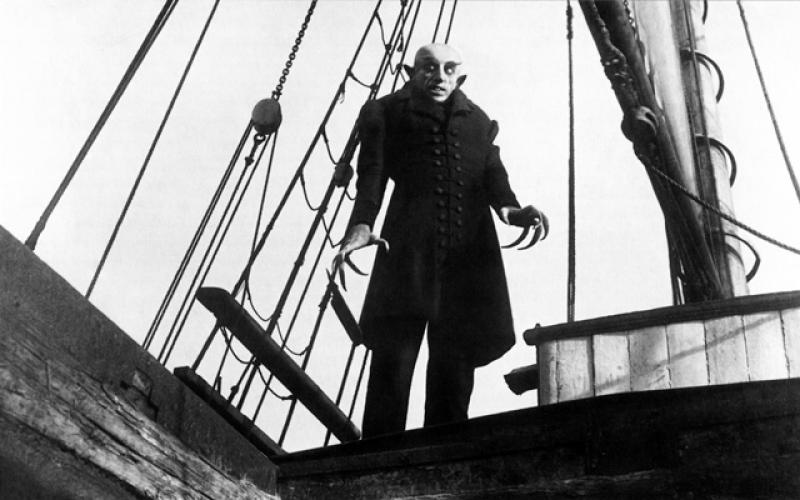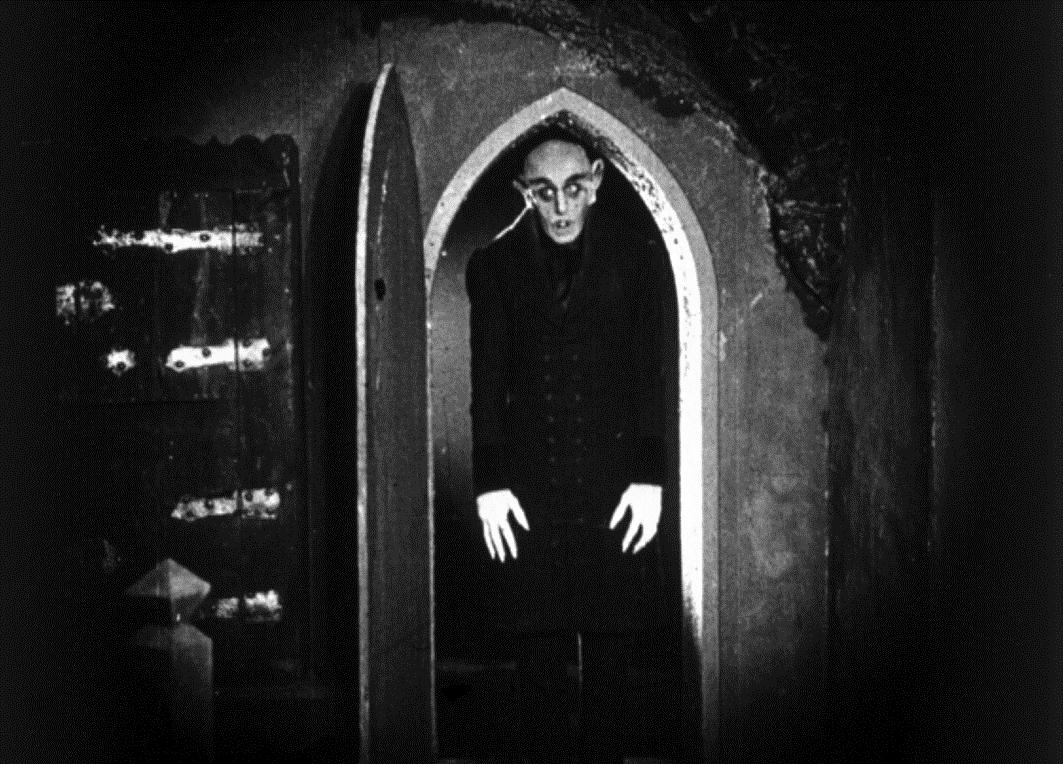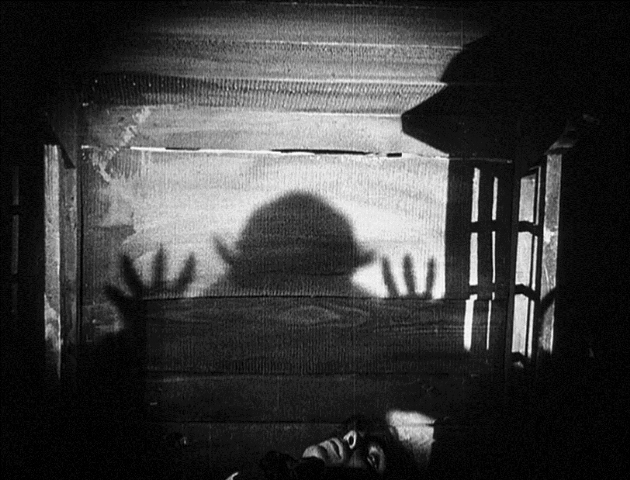Nosferatu, eine Symphonie des Grauens | reviews, news & interviews
Nosferatu, eine Symphonie des Grauens
Nosferatu, eine Symphonie des Grauens
Wonderful, immersive restoration of Murnau’s pioneering silent vampire film

Common sense indicates it’s a rare film which retains the impact it had on first exposure. Films can often reveal new depths and fresh detail with repeated viewing, but that initial effect is tough to duplicate. This new release of FW Murnau’s Nosferatu, eine Symphonie des Grauens actually captures the thrill of the first-time experience. Partly, that’s due to the extraordinary restoration.
Nosferatu should be experienced before a screen in darkness, with the film flooding your senses. It is a powerful, atmospheric film. Seeing it as originally intended brings home the force of its power and atmosphere. The fact that it is a silent film doesn’t matter.
 However, what we see now is not what we would have seen in 1922. Technology has moved on: the image hitting the screen must be more crisp and consistent than in the 1920s, or even the pre-digital 1980s. Two elements are at play with this new release: the restoration and the film itself.
However, what we see now is not what we would have seen in 1922. Technology has moved on: the image hitting the screen must be more crisp and consistent than in the 1920s, or even the pre-digital 1980s. Two elements are at play with this new release: the restoration and the film itself.
The restoration is wonderful. Although the images are sharp, it still looks like a film from the past. The details of the bald wig helping Max Schreck become Count Orlok can be seen. This does not undermine the creepy other-worldliness of his performance, but supplements it by strengthening the bond between his acting and what he portrays. Contrasts between black and white, and light and shade are more pronounced than recollected. In the cinema, the veil lifted by the FW Murnau-Stiftung and Luciano Berriatúa restoration seen here reveals more than could reasonably be expected. Multiple sources are evident: after the “offer what you like, we’re not going any further” intertitle, moments of softness must be evidence for a source different to the bulk employed. The experience overall is supplemented by using Hans Erdmann’s original score as accompaniment and the original German intertitles.
All this forces focus towards the film itself, as barriers - especially any apprehension about seeing a museum piece, akin to taking medicine - to being sucked in are removed. This is not a great horror film, but simply a great film. Aesthetically, the distorted reality of expressionism dominates, but it is really only at 90 minutes that this is fully utilised. Earlier, Orlok’s rise from his coffin in the bowels of the ship carrying him is tremendously impactful.
towards the film itself, as barriers - especially any apprehension about seeing a museum piece, akin to taking medicine - to being sucked in are removed. This is not a great horror film, but simply a great film. Aesthetically, the distorted reality of expressionism dominates, but it is really only at 90 minutes that this is fully utilised. Earlier, Orlok’s rise from his coffin in the bowels of the ship carrying him is tremendously impactful.
What comes through most in this fresh exposure is the allegory driving the film. Gustav von Wangenheim’s Hutter goes off to seek Orlok and returns with more than he was meant to come back with, to his and his wife Ellen’s (Greta Schröder) misfortune. Even while he is away, Ellen and her town-folk are paying the price for Hutter’s encounter with the unknown. The film is a warning about the unforeseen consequences which accompany the adventurer when they return home. Take care after leaving the cinema.
- Nosferatu, eine Symphonie des Grauens is on limited release. Find screening information here
Overleaf: watch the trailer for the restored Nosferatu, eine Symphonie des Grauens
Watch the trailer for the restored Nosferatu, eine Symphonie des Grauens
rating
Explore topics
Share this article
The future of Arts Journalism
You can stop theartsdesk.com closing!
We urgently need financing to survive. Our fundraising drive has thus far raised £49,000 but we need to reach £100,000 or we will be forced to close. Please contribute here: https://gofund.me/c3f6033d
And if you can forward this information to anyone who might assist, we’d be grateful.

Subscribe to theartsdesk.com
Thank you for continuing to read our work on theartsdesk.com. For unlimited access to every article in its entirety, including our archive of more than 15,000 pieces, we're asking for £5 per month or £40 per year. We feel it's a very good deal, and hope you do too.
To take a subscription now simply click here.
And if you're looking for that extra gift for a friend or family member, why not treat them to a theartsdesk.com gift subscription?
more Film
 Can I get a Witness? review - time to die before you get old
Ann Marie Fleming directs Sandra Oh in dystopian fantasy that fails to ignite
Can I get a Witness? review - time to die before you get old
Ann Marie Fleming directs Sandra Oh in dystopian fantasy that fails to ignite
 Happyend review - the kids are never alright
In this futuristic blackboard jungle everything is a bit too manicured
Happyend review - the kids are never alright
In this futuristic blackboard jungle everything is a bit too manicured
 Robert Redford (1936-2025)
The star was more admired within the screen trade than by the critics
Robert Redford (1936-2025)
The star was more admired within the screen trade than by the critics
 Blu-ray: The Sons of Great Bear
DEFA's first 'Red Western': a revisionist take on colonial expansion
Blu-ray: The Sons of Great Bear
DEFA's first 'Red Western': a revisionist take on colonial expansion
 Spinal Tap II: The End Continues review - comedy rock band fails to revive past glories
Belated satirical sequel runs out of gas
Spinal Tap II: The End Continues review - comedy rock band fails to revive past glories
Belated satirical sequel runs out of gas
 Downton Abbey: The Grand Finale review - an attemptedly elegiac final chapter haunted by its past
Noel Coward is a welcome visitor to the insular world of the hit series
Downton Abbey: The Grand Finale review - an attemptedly elegiac final chapter haunted by its past
Noel Coward is a welcome visitor to the insular world of the hit series
 Islands review - sunshine noir serves an ace
Sam Riley is the holiday resort tennis pro in over his head
Islands review - sunshine noir serves an ace
Sam Riley is the holiday resort tennis pro in over his head
 theartsdesk Q&A: actor Sam Riley on playing a washed-up loner in the thriller 'Islands'
The actor discusses his love of self-destructive characters and the problem with fame
theartsdesk Q&A: actor Sam Riley on playing a washed-up loner in the thriller 'Islands'
The actor discusses his love of self-destructive characters and the problem with fame
 Honey Don’t! review - film noir in the bright sun
A Coen brother with a blood-simple gumshoe caper
Honey Don’t! review - film noir in the bright sun
A Coen brother with a blood-simple gumshoe caper
 The Courageous review - Ophélia Kolb excels as a single mother on the edge
Jasmin Gordon's directorial debut features strong performances but leaves too much unexplained
The Courageous review - Ophélia Kolb excels as a single mother on the edge
Jasmin Gordon's directorial debut features strong performances but leaves too much unexplained
 Blu-ray: The Graduate
Post #MeToo, can Mike Nichols' second feature still lay claim to Classic Film status?
Blu-ray: The Graduate
Post #MeToo, can Mike Nichols' second feature still lay claim to Classic Film status?

Add comment